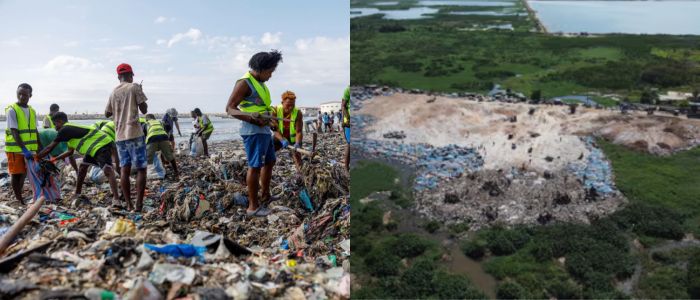An inquiry discovered that clothes made by Next, George at Asda, and Marks & Spencer had been dumped en masse and washed up along waterways. Other items from M&S, Zara, H&M, and Primark have also turned up next to riverbanks en route to conservation zones.
These open dumps are situated in a recognised international wetland area, which plays host to a variety of rare fauna such as the leatherback and green turtle, birds including the roseate tern and the curlew sandpiper. Local communities say their fishing nets, rivers and beaches are clogged with synthetic fabrics, many imported from the UK and Europe.
Accra and Its Surrounding Areas Are Burning Waste
Ghana’s capital, Accra, is inundated with secondhand garments. Kantamanto, one of the largest secondhand clothing markets, takes in more than 1,000 tons of clothes a week. But sellers claim there has been a drop in the quality of the clothes. So many of our goods are damaged, it will take a long time for us to recover.” Trader Mercy Asantewa said that many items are now too damaged to be sold again, and that means families have fewer opportunities to make a living.
There is only one engineered landfill in operation in the region while another is under construction. About 100 tonnes of clothing leave the market daily as waste, but only 30 are collected and processed, says Solomon Noi from Accra’s waste department. The rest — about 70 tons — are deposited in sensitive places like drains, wetlands, lagoons, and the sea.
About 1.5 million tonnes worth of textiles are dumped each year in the UK. Of the total figure, 730,000 tonnes are incinerated or disposed of in landfills, and 650,000 tonnes to recycled or reused. That includes more than 420,000 tonnes that go to export, largely to Ghana.
Demands for an Accounting and Heightened Local Anxieties
Fashion brands including M&S, George, Primark, H&M and Zara confess textile waste is a problem. A few run take-back schemes or back an extended producer responsibility (EPR) regime, under which brands would be responsible for the environmental costs of their products.
Residents are growing more and more frightened. In Akkaway, a recently established dump site has cleared wetlands of vegetation and left the soil bare, without apparent protection measures. There are also fears pollution will seep through to the area’s river and canal waters. The site is supervised by officials from the Weija Gbawe municipal assembly and is not only in clear violation of environmental regulations in Ghana but also in breach of its international obligations under the Ramsar Convention to protect such wetlands.
Residents who live in the vicinity of these dumpsites say they’re increasingly worried. Seth Tetteh, a fisherman, said the river is polluted so bad that it is no longer safe for drinking and fishing nets come out entangled with clothes. Ibrahim Sadiq, a 19-year-old in the area, said it used to be home to wildlife, including alligators and bush cats, but has become infested with mosquitoes, and after rain, a nauseating stench fills the air.
M&S said it did not send surplus clothes to the dump and instead gave shoppers options such as a repair service in conjunction with Sojo and in-store take-back schemes, in collaboration with charities and recycling bodies, as part of its broader efforts to cut the amount of harm it was doing to the environment.
World

UK Clothing Waste Pollutes Ghana’s Protected Wetlands

Consumers' Use of Cast-off Clothing from the UK Becoming a Hazard in Inhabited Wetlands in Ghana, Say Campaigners It was disclosed that the UK is already exporting its cast-off clothing to Ghana, where it is damaging wetlands that support a community of 4,000 people.















